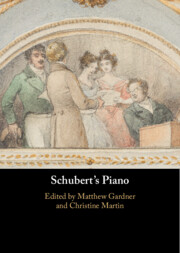Book contents
- Schubert’s Piano
- Schubert’s Piano
- Copyright page
- Contents
- Figures
- Tables
- Music Examples
- Notes on Contributors
- Acknowledgements
- Abbreviations and Conventions
- Introduction
- Part I The Piano in Schubert’s World
- Part II Instruments and Performance
- Part III Sound and Musical Imagery
- Part IV Understanding Schubert’s Writing for the Piano
- 12 Schubert and the Style Brillant: Variation and Figuration in Schubert’s Concertante Chamber Music with Piano
- 13 Rethinking Development and Variation in Schubert’s Last Piano Sonatas: What Do the Drafts and Final Versions Reveal?
- 14 Reflections and Echoes in Schubert’s Waltzes
- 15 ‘Schubert Would Have No Objection if He Knew about It’: Franz Liszt’s Reception of Schubert’s Music
- Select Bibliography
- Index
12 - Schubert and the Style Brillant: Variation and Figuration in Schubert’s Concertante Chamber Music with Piano
from Part IV - Understanding Schubert’s Writing for the Piano
Published online by Cambridge University Press: 31 August 2024
- Schubert’s Piano
- Schubert’s Piano
- Copyright page
- Contents
- Figures
- Tables
- Music Examples
- Notes on Contributors
- Acknowledgements
- Abbreviations and Conventions
- Introduction
- Part I The Piano in Schubert’s World
- Part II Instruments and Performance
- Part III Sound and Musical Imagery
- Part IV Understanding Schubert’s Writing for the Piano
- 12 Schubert and the Style Brillant: Variation and Figuration in Schubert’s Concertante Chamber Music with Piano
- 13 Rethinking Development and Variation in Schubert’s Last Piano Sonatas: What Do the Drafts and Final Versions Reveal?
- 14 Reflections and Echoes in Schubert’s Waltzes
- 15 ‘Schubert Would Have No Objection if He Knew about It’: Franz Liszt’s Reception of Schubert’s Music
- Select Bibliography
- Index
Summary
More than half of Schubert’s chamber works from 1824 to 1828 feature his preferred instrument, the piano. Yet in none of them does it function as an instrumental accompaniment, being instead an equal participant in a duo or trio chamber format. Especially in solo chamber works written for performance in recitals by befriended virtuoso instrumentalists, Schubert was perfectly willing to adapt the style brillant that flourished between 1820 and 1830. Based on the assumption that Schubert applied the style brillant solely for reasons of economy, his virtuoso chamber music has previously been considered to be of lesser value, mentioned only in passing. More recently, however, his turn to extroverted forms of expression has been described as a deliberate counterfoil to the introverted sublimation of his other ‘late’ works. This chapter considers the Fantasy in C Major (D934) and Variations in E Minor on ‘Trockne Blumen’ (D802) to show how Schubert discovered the sophisticated and outgoing mannerisms of the style brillant; it also discusses the development of ornamented variation techniques as an alternative to thematic development, and how this shift of emphasis between musical substance and figuration seems to anticipate the aesthetics of the Romantic arabesque.
Keywords
- Type
- Chapter
- Information
- Schubert's Piano , pp. 241 - 258Publisher: Cambridge University PressPrint publication year: 2024

